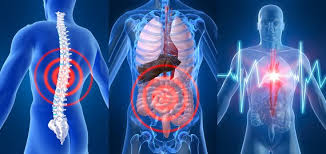The human body functions on three levels – physical, chemical and energetic.
Conventional medicine focuses on the physical and chemical aspects of the human body and employs the biochemical and biomechanical, or physical, models of healing. As such, it is the only medical system ever known to mankind which has no concept of biological energy.
The physical aspect involves our body structure – bones, organs and tissues. The biomechanical model of Western medicine includes all surgical interventions, such as repairing a fractured bone or removing damaged tissue (eg appendix) or replacing an ineffective organ (eg transplants).
The biochemical model focuses on changing the cell’s chemistry using medications which tend to ‘block’ a given reaction within the body. For example when the body produces histamine in response to an ingested or inhaled substance resulting in an allergic reaction, anti-histamines may be administered. Elevated cholesterol production is ‘blocked’ using Statin drugs which cause a myriad of other non-beneficial side-effects.
Energetic or biophysical medicine is based on the approach that illness is the result of disrupted communication between cells. Natural medicine aims to restore the body’s healing capacity by improving communication between cells and reducing the body’s toxic load, which will be undermining its ability to heal itself.

The first difference between natural and conventional medicine is that natural medicine emphasises maintaining health and preventing illness, whereas Western medicine waits until something goes wrong and looks for a cure. Natural medicine supports the body’s healing ability by relieving it of its stressors which are the causes of illness. Rather than suppressing an illness with chemicals or drugs, natural medicine incorporates many techniques to nurture the body so that its resources are strengthened to effect its own cure.
A second difference between natural medicine and Western concepts of healing is that conventional medicine applies treatments on the basis of diagnostic categories, with the treatment assumed to be relevant for everyone with the same set of symptoms. In contrast, natural medicine believes that the same symptoms can have a range of underlying causes and that the treatment has to be tailored for each individual. This is known as individual remedialisation – the foundation of natural medicine.
While the two medicine paradigms differ in their approach and execution, BOTH form an essential part of comprehensive health care.
The value of interprofessional health care & the prevalence of complex chronic health conditions
The Australian Institute of Health and Welfare in 2017-2018 estimated that 20% of Australians (4.9 million people) had two or more of the following ten selected chronic conditions1:
| Mental & behavioural conditions | 4.8 million |
| Back problems | 4 million |
| Arthritis | 3.6 million |
| Asthma | 2.7 million |
| Diabetes Mellitus | 1.2 million |
| Heart, stroke & vascular disease | 1.2 million |
| Osteoporosis | 924,000 |
| Chronic Obstructive Pulmonary Disease | 598,000 |
| Cancer | 432,000 |
| Kidney disease | 237,800 |
This state of health is known as “multi morbidity” and people with three or more chronic conditions are classed as having “complex multimorbidity”2.
Despite this prevalence of complex chronic conditions, the Australian health system is largely designed to manage single conditions. However, such a focus overlooks the complexity of these conditions.
Interprofessional practice refers to collaboration among health practitioners from different professions to achieve positive clinic results for patients.
For optimum health and wellness outcomes for all Australians, an interprofessional approach between conventional and natural/complementary medicine should be the goal.
- ABS. National Health Survey: first results, 2017-18. ABS cat.no. 4364.0.55.001. Canberra: Australian Bureau of Statistics 2018
- Harrison C, Henderson J, Miller G, Britt H. The prevalence of complex morbidity in Australia. Australia and New Zealand Journal of Public Health. 2016;40(3):239-44
